
Original Link: https://www.anandtech.com/show/2206
Intel Core 2 Extreme QX6800: The Fastest Desktop CPU, now with more cores
by Anand Lal Shimpi on April 9, 2007 12:59 PM EST- Posted in
- CPUs
If you go to school for marketing, there's undoubtedly a lesson about announcing products too early while you still have older inventory to sell. Two weeks ago, Intel unveiled its plans for Penryn and Nehalem, the successors to Conroe, in the most forward looking disclosure we've ever seen from the company. We couldn't be happier with the way Intel has been handling itself ever since the demise of NetBurst and the Pentium 4, but admittedly it's incredibly difficult to get excited about a Kentsfield speed bump in the interim.

Until today, if you needed a quad-core desktop CPU from Intel you had to sacrifice a little clock speed. The Core 2 Extreme QX6700 ran at 2.66GHz while the fastest dual core Conroe ran at 2.93GHz; today, thanks to continuing improvements in yields Intel is unveiling the Core 2 Extreme QX6800 running at an equivalent 2.93GHz, priced at $1,199.
Given that the Core 2 Extreme X6800 is already the fastest desktop processor in the world, adding two more cores gives you the absolute best of both worlds. You get the highest stock clock speed Intel offers for the best performance in lightly multithreaded (or single threaded) applications, and a total of four cores for those heavy multitasking or CPU intensive multithreaded scenarios.

There's not much else to know about the new processor, so we'll direct you back to our previous coverage of Intel's Kentsfield core for more detail. Indeed the more interesting processor launches this year will involve Intel's 1333MHz FSB offerings, AMD's Barcelona and by the end of the year Penryn.
The Real Story is Pricing
Even though we are a tad spoiled by Intel (just a year ago we would have given anything to see such a high performing part come out of the maker), the real story here is in the pricing war that these two competitors have found themselves engaged in. Let's first take a look at Intel's pricing, including the new QX6800:
| CPU | Clock Speed | L2 Cache | Price |
| Intel Core 2 Extreme QX6800 | 2.93GHz x 2 | 4MB x 2 | $1199 |
| Intel Core 2 Extreme QX6700 | 2.66GHz x 2 | 4MB x 2 | $999 |
| Intel Core 2 Extreme X6800 | 2.93GHz | 4MB | $999 |
| Intel Core 2 Quad Q6600 | 2.40GHz x 2 | 4MB x 2 | $851 |
| Intel Core 2 Duo E6700 | 2.66GHz | 4MB | $530 |
| Intel Core 2 Duo E6600 | 2.40GHz | 4MB | $316 |
| Intel Core 2 Duo E6400 | 2.13GHz | 2MB | $224 |
| Intel Core 2 Duo E6300 | 1.86GHz | 2MB | $183 |
| Intel Core 2 Duo E4300 | 1.80GHz | 2MB | $163 |
As you can see, it hasn't changed much, the price points are the same with the addition of the QX6800 at the $1200 mark (as if Extreme Edition/FX pricing wasn't high enough). But now let's take a look at what AMD has done since we last looked at the desktop CPU market:
| CPU | Clock Speed | L2 Cache | Price |
| AMD Athlon 64 X2 6000+ | 3.0GHz | 1MBx2 | $241 |
| AMD Athlon 64 X2 5600+ | 2.8GHz | 1MBx2 | $188 |
| AMD Athlon 64 X2 5200+ | 2.6GHz | 1MBx2 | $178 |
| AMD Athlon 64 X2 5000+ | 2.6GHz | 512KBx2 | $167 |
| AMD Athlon 64 X2 4800+ | 2.5GHz | 512KBx2 | $136 |
| AMD Athlon 64 X2 4400+ | 2.3GHz | 512KBx2 | $121 |
| AMD Athlon 64 X2 4000+ | 2.1GHz | 512KBx2 | $104 |
| AMD Athlon 64 X2 3800+ | 2.0GHz | 512KBx2 | $83 |
| AMD Athlon 64 X2 3600+ | 1.9GHz | 512KBx2 | $73 |
The fastest AMD processor you can buy will only set you back $241 today - and these are actual prices. A quick check on Newegg reveals that the X2 6000+ can actually be had for $239. In our review of the 6000+ we stated the following:
"With the latest round of price cuts AMD is far more competitive than at any other point since the release of Intel's Core 2 processors. Unfortunately for AMD, this means that at best, it can offer performance close to that of Intel's Core 2 processors at similar prices."
With another round of price cuts AMD can potentially change the balance structure even more, at $241 the 6000+ is really a competitor to the Core 2 Duo E6400, which it should have no trouble outperforming. The 5600+ ends up competing with the E6300 and the 5000+ is priced equivalently to the E4300. While Intel will still hold control of the world's fastest desktop processor title, AMD may actually offer better value at lower price points.
Intel surely won't allow its newly found fanbase to go challenged, and thus on April 22nd it will respond with its own set of price cuts resulting in the following table:
| CPU | Clock Speed | L2 Cache | Price |
| Intel Core 2 Extreme QX6800 | 2.93GHz x 2 | 4MB x 2 | $1199 |
| Intel Core 2 Extreme QX6700 | 2.66GHz x 2 | 4MB x 2 | $999 |
| Intel Core 2 Extreme X6800 | 2.93GHz | 4MB | $999 |
| Intel Core 2 Quad Q6600 | 2.40GHz x 2 | 4MB x 2 | $530 |
| Intel Core 2 Duo E6700 | 2.66GHz | 4MB | $316 |
| Intel Core 2 Duo E6600 | 2.40GHz | 4MB | $224 |
| Intel Core 2 Duo E6400 | 2.13GHz | 2MB | $183 |
| Intel Core 2 Duo E6300 | 1.86GHz | 2MB | $163 |
| Intel Core 2 Duo E4300 | 1.80GHz | 2MB | $113 |
The April 22nd price cuts aren't terribly aggressive, but they do restore a little balance to the equation . The 6000+ goes back to compete with the E6600 instead of the E6400, which does change things thanks to the E6600's larger L2 cache. The 5600+ now goes head to head with the E6400 instead of the E6300, and the 5000+ will have to contend with the E6300.
Unfortunately, the timing of today's launch requires us to look at the market in two ways: as if you were buying components for a system today, and if you were buying in a couple of weeks after Intel's price cuts take effect. The latter obviously being more important given its imminence.
The Test
While the major benchmark suites still lack support for the OS, we are trying our hands at testing CPUs under Windows Vista with this review. By now we know not to expect a significant performance difference between Windows Vista and XP, but given Vista's compelling feature set we see it becoming the dominant PC OS for new system builds in the enthusiast community.
With a substantial number of our CPU benchmarks available in 64-bit versions, using the 64-bit version of Vista wasn't a difficult choice. Since we're also using modern components in our testbeds, driver support wasn't an issue either. Given what we saw in our Vista Performance Guide, the ability to use more memory for features like SuperFetch warrants the switch to 64-bit if you don't have any legacy hardware without driver support.
The only other change we've made to our test beds is the use of 4GB of memory; by no means is it necessary (yet) but Vista's added memory requirements coupled with its better use of free memory makes 4GB a good target for enthusiasts.
| CPU: | AMD Athlon 64 X2 6000+ (3.0GHz/1MBx2) AMD Athlon 64 X2 5600+ (2.8GHz/1MBx2) AMD Athlon 64 X2 5000+ (2.6GHz/512KBx2) AMD Athlon 64 X2 3800+ (2.0GHz/512KBx2) Intel Core 2 Duo E6700 (2.66GHz/4MB) Intel Core 2 Duo E6600 (2.40GHz/4MB) Intel Core 2 Duo E6300 (1.86GHz/2MB) |
| Motherboard: | ASUS P5B Deluxe (P965) ASUS M2N32-SLI Deluxe (nForce 590 SLI) |
| Chipset: | Intel P965 NVIDIA nForce 590 SLI |
| Chipset Drivers: | Intel 8.1.1.1010 (Intel) Integrated Vista Drivers (NVIDIA) |
| Hard Disk: | Seagate 7200.9 300GB SATA |
| Memory: | Corsair XMS2 DDR2-800 4-4-4-12 (1GB x 4) |
| Video Card: | NVIDIA GeForce 8800 GTX |
| Video Drivers: | NVIDIA ForceWare 100.54 |
| Desktop Resolution: | 1600 x 1200 |
| OS: | Windows Vista Ultimate 64-bit |
General Performance
Although our usual general performance suites aren't available under Vista, something we often use in our motherboard reviews is: PCMark '05. PCMark is a somewhat unusual benchmark as it is a synthetic performance test that tries really hard to be applicable to the real world.
The tests used by PCMark '05 and the applications they are based off of are listed in the table below:
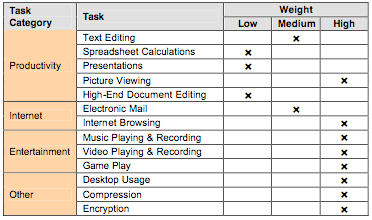
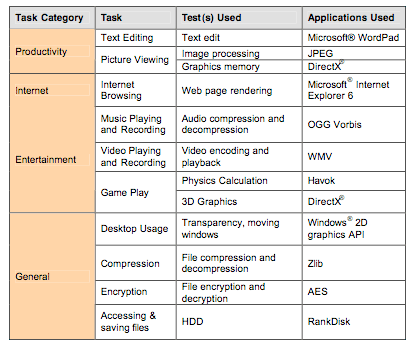
We focused on two of the PCMark tests: the system test suite and the CPU test suite. The system test suite is composed of the following tests:
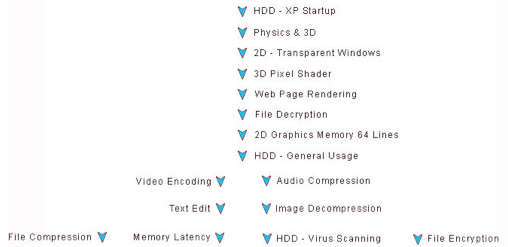
And the CPU test suite consists of the following tests:
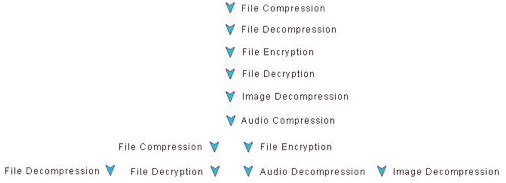
We reported the overall PCMark and CPU test scores.
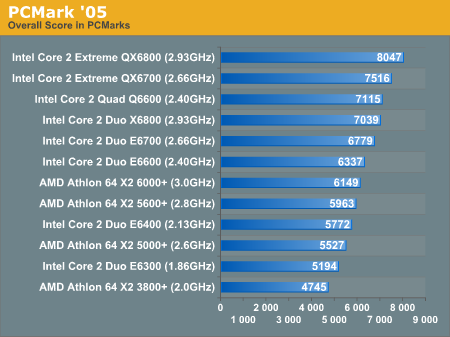
PCMark has a handful of heavily multithreaded tests which obviously favor more cores, hence the three quad-core offerings dominating the charts here. Moving down the list however we see that the X2 6000+ manages to come in just under the E6600 in performance, but remains ahead of the E6400. The 5600+ remains ahead of both the E6400 and E6300, its two chief competitors based on price.
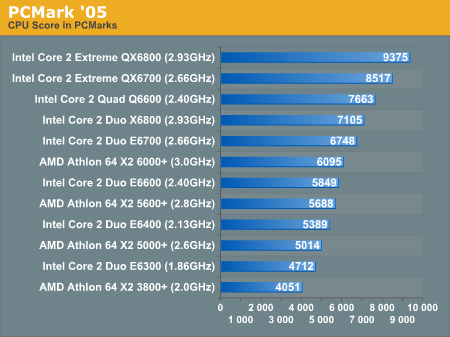
Isolating the CPU score itself doesn't change things much, although AMD looks a tad better in some of the results.
Media Encoding Performance
Although DivX was one of the first areas we saw performance gains with when moving to 64-bit years ago, our codec and encoding front end are both still 32-bit applications. We've moved to DivX 6.5.1 but our test settings remain the same. We use the codec in its unconstrained profile, using a quality present of 5 in 1-pass mode. Enhanced multithreading is enabled and we report encoding frame rate for our 1080p source file.
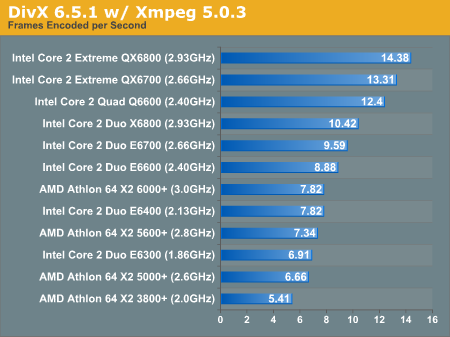
Media encoding and 3D rendering are two obvious areas where having four cores will boost performance significantly, and thus we see the four quad-core offerings at the top of the charts once more.
Moving down the list, the 6000+ performs exactly the same as the E6400, its price competitor. After Intel's price cuts take effect, the 6000+ will have to compete with the E6600 which is about 14% faster in our DivX test. The 5600+ does quite well, falling right between the E6400 and E6300 in performance.
Windows Media Encoder is available in a 64-bit version and thus we used that here as one of our encoding tests. Our test remains the same as we've run it in the past, only using the 64-bit version of WME instead of the 32-bit version. Performance is reported in frames encoded per second:
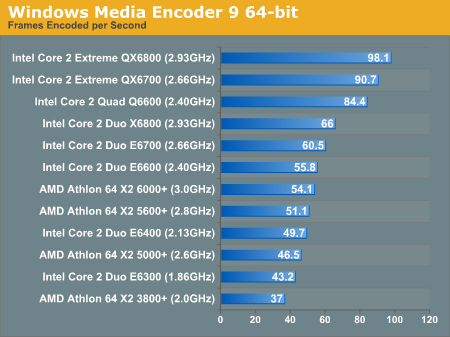
We also looked at encode time using Windows Movie Maker, a 64-bit application that comes with Windows Vista. We measured the time it took to encode content recorded off of Media Center into a format for posting on YouTube. Encode time was measured in seconds:
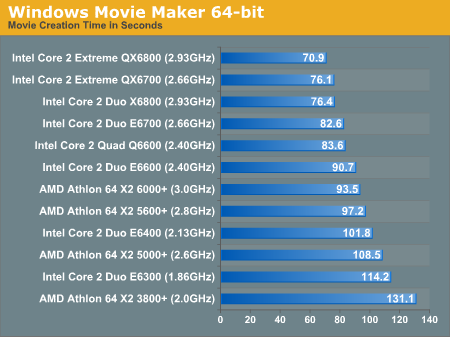
H.264 encoded content is still not mainstream yet, but the benefits of storing your content in the new format are numerous. We measured H.264 encode performance using Quicktime and report the results in frames encoded per second:
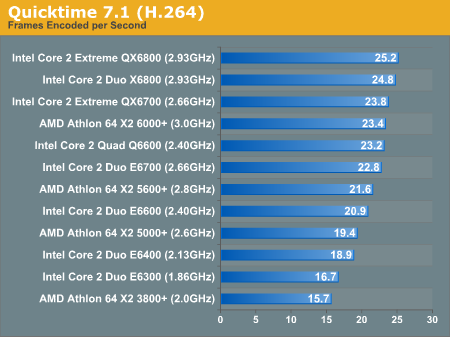
The Quicktime H.264 test paints a particularly good picture for AMD, with the 6000+ equalling even the Q6600.
We conclude our look at Media Encoding performance with a simple conversion from a 304MB wav file to a 192kbps MP3 using iTunes. The conversion rate is reported in MB/s:
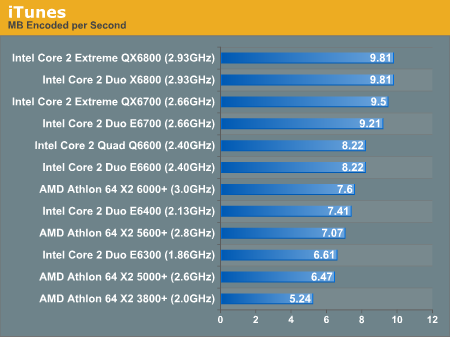
3D Rendering Performance
We've moved on to using 3dsmax 9, which allows us to run a 64-bit version of the program for our tests. The test scenario is still made up of the CPU rendering tests of the SPECapc 3dsmax benchmark. We report the rendering composite, which is simply the geometric mean of render times across seven benchmarks normalized to a set of reference scores. We ran 3dsmax 9 using its Direct3D driver given the poor state of OpenGL performance under Windows Vista.
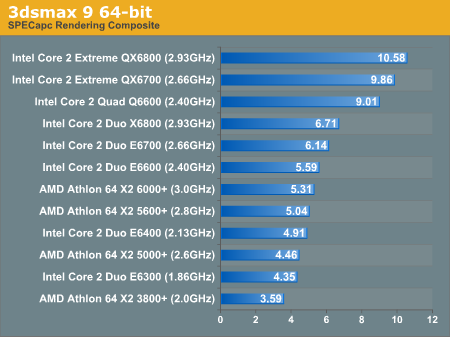
Quad-core performance is even more pronounced in 3D rendering applications, with the QX6800 maintaining a 58% performance advantage over its dual core predecessor.
The price war continues with the 6000+ falling in between the E6600 and E6400 in performance, while the 5600+ outperforms both of its competitors.
Lightwave 3D 9.0 is available with 64-bit support, giving us another 64-bit 3D rendering test. We looked at performance under two scenes that ship with the program: Dirty_Building and Record_Player. We measured the time it took to render the scene in seconds, lower numbers are obviously better.
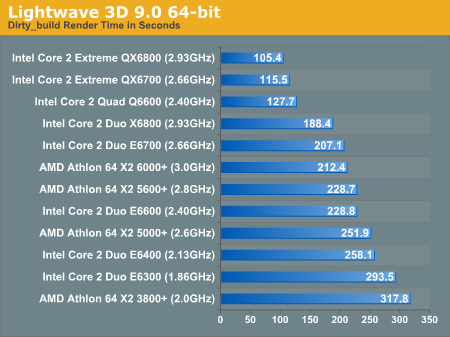
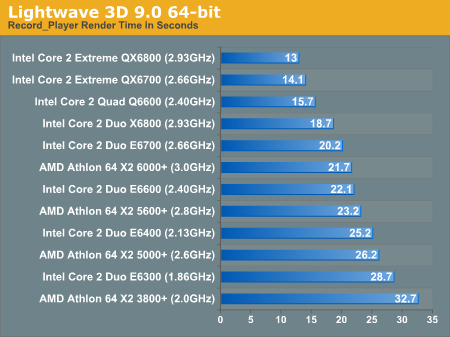
POV-Ray's ray tracing benchmark has been a popular CPU test for quite some time, and we turn to its 64-bit SMP beta to stress the CPUs here today:

Our final 3D benchmark is the 64-bit version of Cinebench 9.5, a fairly popular 3D rendering benchmark due to its ease of use and quick runtimes. We ran the multi-threaded CPU rendering test and reported the final score in CBmarks. Higher numbers are better:
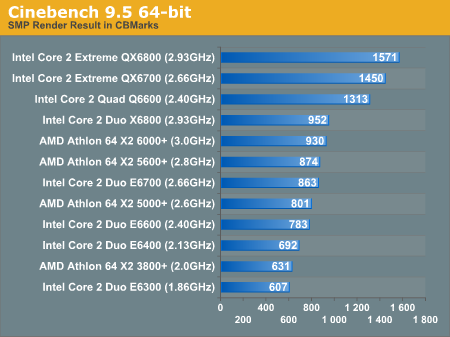
Photo Processing Performance
We turned to the Retouch Artists Photoshop Speed Test for measuring CPU performance in Adobe's Photoshop CS3 beta. The benchmark applies a number of actions to a test image while we measure the total time elapsed during the active portion of the test. We report results in seconds, with lower scores denoting higher performance.
We set history states to 1 and cache levels to 4; CS3 was configured to make use of all available system memory.
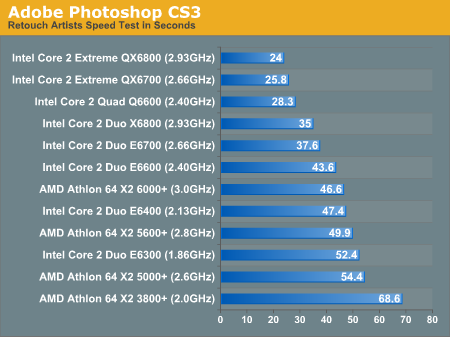
The speedup from going to four cores isn't as great in Photoshop as in the 3D rendering tests, but it's still significant (and worth it if you spend a lot of time in Photoshop). The AMD/Intel breakdown remains the same as we have seen in all of our other tests.
Our next test is one recommended by Intel, but the test itself appears to be fair as it is a simple task using one of Vista's built in applications: Windows Photo Gallery. This test simply measures the amount of time required to print four sheets of thumbnails; of course we don't measure actual printing time, rather the benchmark exports the pictures to an Excel spreadsheet. Time is measured in seconds, with lower times resulting in better performance:
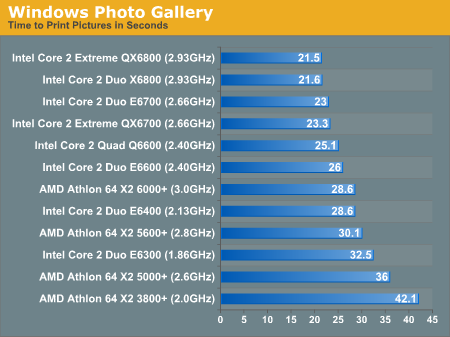
Finally we have a benchmark that was one of the first tests AMD sent around a while back to showcase what 64-bit processors could do for performance. The application is called the Panorama Factory and it is used to stitch together multiple digital pictures in order to make one larger picture, or a panorama. The stitching process can be quite CPU intensive so we used the benchmark to stitch together 10 6MP images of a room and reported the total process time:

Gaming Performance
Given that we were running under Windows Vista, we only focused on DirectX gaming performance due to the current state of OpenGL performance in the new OS. All of our game benchmarks are 32-bit.
First up is Oblivion, where we benchmarked a timed FRAPS run through of a savegame within the Bruma town gates. Oblivion has just as many CPU bound situations as it does GPU bound situations, this benchmark is merely one of the CPU bound cases. We tested Oblivion with the 1.1 patch and the game's default Very High quality settings, which can still be CPU bound with an 8800 GTX at 1600 x 1200:

We measured performance in Half Life 2: Episode One using a custom recorded timedemo, the same benchmark we've used in previous reviews. All quality settings were set to their highest values except for AA and AF which remained disabled.
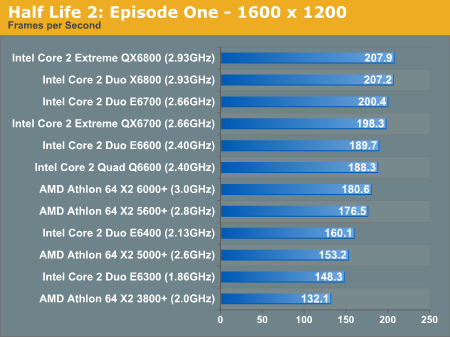
Finally we have Battlefield 2 performance, using in game High quality settings and the same benchmark we've used in previous reviews:

Final Words
The performance crown continues to undeniably belong to Intel, the QX6800 simply gives you the option of having four cores at the performance leading clock speed. The price is obviously quite steep, and those who are not opposed to overclocking would be better off buying a Q6600 and simply overclocking it to QX6800 speeds. It would make even more sense to wait until the end of April and buy a Q6600 for $530 and then overclock it, if you truly want four cores at close to 3.0GHz. Other than the price however, there's nothing wrong with the QX6800 - it's got four cores that we all know and love, and it's fast.
Penryn is several months away, so waiting to build isn't really an option if you need a computer now. If you already have a Core 2 system, please do resist the urge to upgrade until Penryn and Barcelona come out as you'll have better performing choices and/or cheaper alternatives.
Pricing is a major focus of the desktop CPU industry these days, and believe it or not, CPU prices will get even more competitive by the end of the year. Thanks to AMD's recent price cuts the Athlon 64 X2 line is finally competitive, across the board, with Intel's offerings. The Athlon 64 X2 6000+ is a realistic alternative to the E6600/E6400, the 5600+ competes well with the E6400/E6300 and the 5000+ can hold its own against the E6300/E4300. At these prices, you really can't go wrong with either AMD or Intel. If you want the absolutely highest performance, Intel is still your only option, but at the sub-$300 mark both companies are quite competitive.
For the consumers, things couldn't be better - you actually have even more choice today than when Intel's Core 2 processors first arrived. Back then, none of the AMD processors made any sense to purchase, but today you can't go wrong with either. From a market standpoint however, things aren't looking so good for AMD. In less than a year, Intel managed to relegate the strong, competitive AMD back to the company it used to be: simply offering good value. Hopefully, for AMD's sake, Barcelona can restore some of the performance leadership again - otherwise these next two years are going to be rough with back-to-back launches of Penryn and Nehalem.







